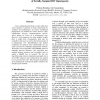Free Online Productivity Tools
i2Speak
i2Symbol
i2OCR
iTex2Img
iWeb2Print
iWeb2Shot
i2Type
iPdf2Split
iPdf2Merge
i2Bopomofo
i2Arabic
i2Style
i2Image
i2PDF
iLatex2Rtf
Sci2ools
CSB
2004
IEEE
2004
IEEE
MinPD: Distance-Based Phylogenetic Analysis and Recombination Detection of Serially-Sampled HIV Quasispecies
A new computational method to study within-host viral evolution is explored to better understand the evolution and pathogenesis of viruses. Traditional phylogenetic tree methods are better suited to study relationships between contemporaneous species, which appear as leaves of a phylogenetic tree. However, viral sequences are often sampled serially from a single host. Consequently, data may be available at the leaves as well as the internal nodes of a phylogenetic tree. Recombination may further complicate the analysis. Such relationships are not easily expressed by traditional phylogenetic methods. We propose a new algorithm, called MinPD, based on minimum pairwise distances. Our algorithm uses multiple distance matrices and correlation rules to output a MinPD tree or network. We test our algorithm using extensive simulations and apply it to a set of HIV sequence data isolated from one patient over a period of ten years. The proposed visualization of the phylogenetic tree\network fur...
Bioinformatics | CSB 2004 | Phylogenetic Tree | Phylogenetic Tree Methods | Traditional Phylogenetic Methods |
| Added | 20 Aug 2010 |
| Updated | 20 Aug 2010 |
| Type | Conference |
| Year | 2004 |
| Where | CSB |
| Authors | Patricia Buendia, Giri Narasimhan |
Comments (0)

